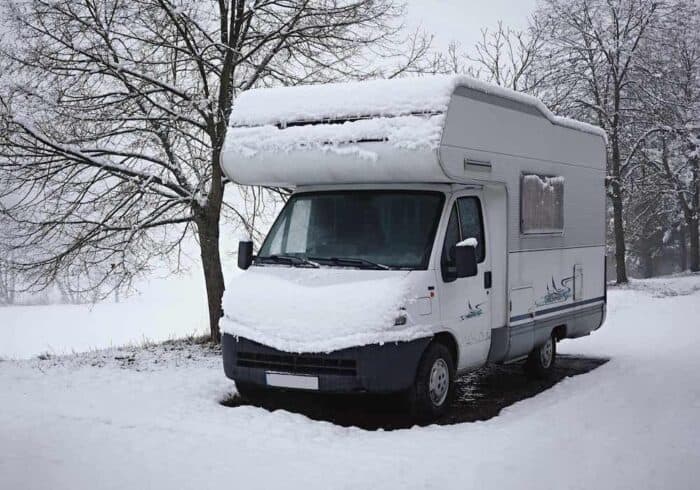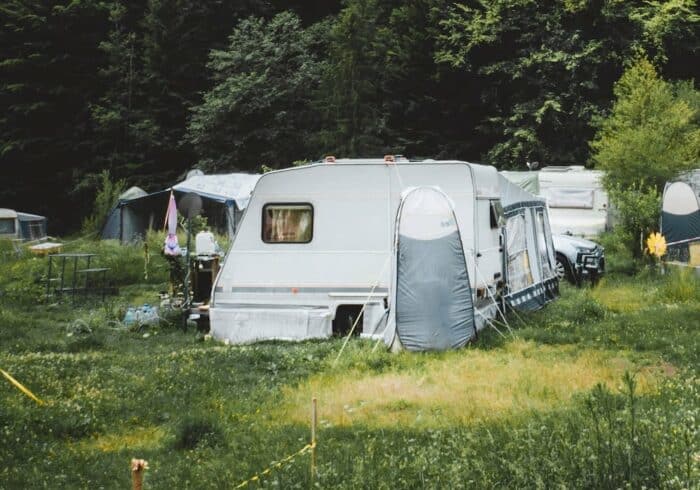Dealing with Unexpected Freezing Weather in an RV Without Electricity
When temperatures start to dip below freezing at night, RVers will either winterize and store their camper for the winter, or head south to warmer temperatures.
Even if you are planning on traveling south, that doesn’t mean you won’t experience some freezing weather.
Fall and spring weather can be unpredictable. Sometimes there’s an early (or late) frost. Temperatures can drop well below freezing all night long for just one night.
Related Product: Use a Camco Heated Drinking Water Hose (click to view on Amazon) in cold or freezing temperatures.
One extra cold night shouldn’t keep you from RV camping or cause your RV water pipes to freeze.
You can do things to help keep the pipes and water system in your RV from freezing even when you aren’t connected to electricity.
In this post, I’ll go over some of the things we’ve done to stay warm in unexpected cold weather without electrical hookups.
This is mostly for RVers who are only going to experience a few nights of freezing weather, it’s not for full time winter weather campers who live in RVs in cold climates.
See Also: How Cold Can It Get Before I Need To Winterize My RV?
5 Tips That Will Help Stop an RV From Freezing without Electricity
1. Insulate Windows & Vents
Probably the smartest thing I ever did when RV camping in freezing weather is cover all of the windows and vents from the inside.
RVs are notorious for being poorly insulated.
That is unless you have a four season camper that’s extra insulated for winter conditions, but even those can lose a lot of heat through the windows and vents.
Use extra blankets, cushions from the dinette, extra foam pads, pillows, hoodies, and whatever else you can find that is going to be able to fully cover the windows in your RV.
In our travel trailer with a mega slide out, we found that stuffing blankets around the inside frame helped keep cold air from getting it, and hot air from getting out.
See Also: Best Portable Power Station/Solar Generator For Camping
It also helped to put all of our rugs along the gap in the floor created by the slide out.
In our Class C motorhome, we hung heavy blankets across the cab area to cut it off from the rest of the RV.
We also put cushions from our dinette seat across the over cab bed to seal off the space that we weren’t going to use.
I recommend getting RV vent insulation covers that you put in vents and skylights from the inside.
The ones made by Camco (click to view on Amazon) have a reflective layer on one side and synthetic fleece on the other.
They really help keep the heat inside during the winter and are even useful when running the AC during the summertime.
If you are using an indoor propane heater like any of the ones in this review here (click to go to).
Make sure you leave a vent uncovered and slightly cracked for proper ventilation. Trust me, the propane heater ventilation thing is no joke.
Keeping as much heat inside as possible is key to keeping your RV water pipes from freezing in cold temperatures when boondocking.
You don’t have unlimited power to run an electric heater 24/7, so you have to be a little smarter about keeping in the heat.

2. Open Things Up For the RV Water Pipes
RV water pipes are made of 1/2 inch PEX pipes. They are made to be able to expand and take some freezing, but the connections and joints aren’t so forgiving.
Because of their small size, they are very susceptible to freezing. It doesn’t take a lot of cold air to get ice forming in a small tube of water.
Normally, water pipes in an RV are run along the walls. They will be behind cabinets, sofas, and beds, They can also be under dinette seats and bunks.
When it’s really cold outside some of the spaces behind cabinets and under bunks can get to freezing temperatures even though the inside of the RV is warm.
Try and find ways to get warm air to the RV water pipes. Open up cabinets, and the dinette, check behind the sofa and under the beds to make sure there’s nothing blocking air from the pipes.
Pay extra close attention to the connection between the freshwater tank and the RV water pump.
This area can sometimes be exposed to lots of cold air if the water tank is underneath the RV.
See Also: Which RV Blowout Adapter Plug For Winterization is Best?
Also, check the outer storage compartments. Sometimes the water filter and pump will be stored in one of the compartments instead of inside the RV.
If this is the case, try and insulate the storage doors as much as possible and find a way to get heat into the compartment.
Opening up the inside of the RV will probably create some spots for hot air to escape, but it’s important to keep the RV water pipes at an above freezing temperature.
Also, keep the hot water heater on. You can also wake up periodically through the coldest temperatures and run water through every tap, shower, and toilet.
This will help stop freezing in both the hot and cold water pipes.
3. Keep the Freshwater, Black, and Grey Tanks Over 1/2 Full
It’s harder to freeze larger amounts of water than smaller amounts.
If it’s going to be below freezing for 12 or so hours, a 30 to 50 gallon tank that’s over 1/2 full shouldn’t freeze.
As an extra precaution, you can even add some RV antifreeze to the black and grey tanks. This will help keep the gate valves from freezing as well.
Many RVers will install electric holding tank heaters (click to view on Amazon) for the cold season.
RV tank heat pads like the ones I linked to above use 12 volt power, so you can technically use them when boondocking if you have a big enough battery bank to handle the extra power draw.
The biggest ones will draw 5.8 amps (78 watts) each.
If you have one on the black, grey, and freshwater that’s 234 watts being used an hour, which is a lot of power if you’re running other things like the RV furnace.
If you have a large battery bank or are planning on running a generator all night you could power RV tank heat pads, so it’s a possible option for boondockers who have the resources for it.
See Also: Best Portable Quiet Inverter Generators For RV Camping
4. Use Alternative Heat Sources to the RV Furnace
An RV furnace uses a lot of electricity. Even though they heat with propane, the fan uses electricity, which can drain an RV battery really fast.
With that being said, if you’re a boondocker with an extra large battery bank or you are planning on running a generator all night, you should be able to run the RV furnace all night to stay warm.
There are more cons to RV furnaces than just the power usage, they are noisy and use a lot of propane.
If you have the ability to get an indoor safe portable propane heater like one of the ones in this review that’s one good way to get heat without using any electricity.
Another option for future freezes and cold weather camping is to replace the large propane RV furnace with a diesel heater.
Diesel heaters are small, quiet, and fairly easy to install.
They use very little electricity compared to RV furnaces and are safe to use in vans and RVs when installed correctly.
You can read more about diesel heaters in this post here.
If you have a portable power station or are using a generator and have access to 120 volt power, you can also use heated blankets and heated RV mattress pads to keep the RV nice and warm.
I recommend heated RV mattress pads since they are a little more effective than heated blankets and don’t lose as much heat.
But either option is a great way to keep you warm in your RV when temperatures are below freezing outside.
5. Skirt the RV
This tip takes a little more work, and it may not be necessary if it’s only going to go below freezing for one night.
But if it’s going to be really windy outside, it’s an effective way to keep underneath and inside the RV just a bit warmer.
RV skirting is when the bottom of an RV is covered and closed off from the outside.

Full time RVers who live in RVs in winter climates have to skirt their RVs, it’s one of the only ways to survive temperatures that are below freezing 24/7.
If it’s going to be windy on the night of the freeze, you may want to consider doing whatever you can to close off underneath your RV to avoid wind chill.
Wind chill can drop temperatures well below what is forecasted.
Freezing wind underneath your RV lets in even more cold air and makes it even harder to keep the holding tanks and inside from freezing.
See Also: Best Heated RV Sewer Hose Review For Winter RV Camping
Even if you just take a tarp and secure it around the bottom of your RV on the side the wind will be blowing from helps.
If you have time to run to a hardware store, foam insulation board works really well as a lightweight RV skirt that’s easy to setup and take down.
It’s not something you absolutely have to do, but if you are camping without electricity, it’s a good way to help insulate and make the heat you can get last a little longer.
Have any more questions or ideas about how to keep an RV from freezing when boondocking without electricity? Leave a comment below.



